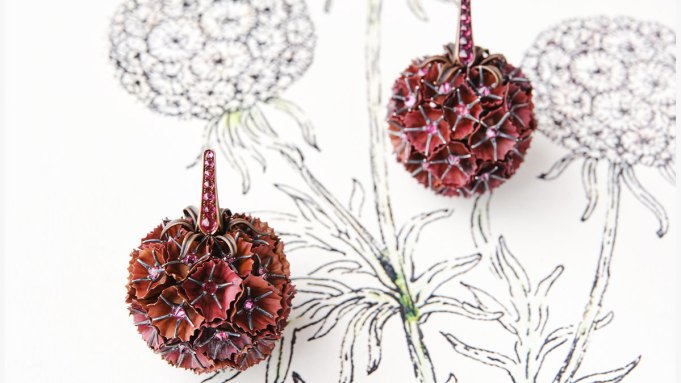As with so many of Hemmerle’s jewelry creations, inspiration began with a flower, this time, the scabiosa stellata, also known as starflower. Plucked from nature and brought into the workshop, its delicate, papery, bronze-colored seed heads sparked the imagination of the Munich-based family-owned house. The challenge, of course, was to recreate that ethereal spirit—the texture, sculptural form, subtle color tones—in wearable metal and gemstones.
“An idea is just the beginning,” says Yasmin Hemmerle, who with her husband Christian helms the heritage brand. “Our master goldsmiths thrive on experimentation and pushing boundaries. And they had no time constraints.” The earrings took more than two years to complete.
Hemmerle is known for its sculptural designs fused with technical ingenuity, often using unexpected metals—like copper, bronze, and aluminum—to achieve distinct tones and lightness. The Scabiosa Stellata earrings are the most time-consuming design from the workshop to date, requiring more than 600 hours at the bench, says Hemmerle. Entirely handmade, they combine copper, bronze, silver and white gold, with over 90 reverse-set Umba sapphires weighing a total of five carats. These are a unique variety of naturally vibrant reddish-orange found only in Tanzania’s Umba River Valley.
“When you see these earrings on, they appear articulated and light,” Hemmerle says. “The craftsmanship is so complex, but the result is something simple, organic, and almost as if they fell off the tree.” That is the point: not to impress with ostentation or big stones, but to evoke quiet wonder.
During a recent to visit to Hemmerle’s multi-level workshop in the heart of Munich, I saw the earrings in progress, as a goldsmith proudly shared the elements yet to be assembled. The workshop is like a metalsmith’s laboratory, where craftsmen skilled in traditional goldsmithing techniques constantly experiment with new materials and methods. It’s a collaborative setting that requires both precision skills and boundless imagination. Here’s a look at the steps behind the house’s most complex design to date.
Authors
